According to this forum post, what is happening is that plotly.express is interpreting start_time as a continuous variable which is why you get a colorbar, but then falls back onto stacking the bars instead of grouping them.
As suggested by @Emmanuelle, you could solve this by creating a new start_time column that is a string called start_time_str, then pass this column to the color argument. This forces plotly.express to interpret this variable as discrete. However, you would then lose the color bar and get a legend:
data['start_time_str'] = data['start_time'].astype('str')
fig = px.bar(data.sort_values("start_time", ascending=False), x="teacher", y="start_time", color="start_time_str",color_continuous_scale="Bluered", barmode="group")

So assuming you want to preserve the colorbar, and have stacked bars, you'll need a more complicated workaround.
You can use plotly.express to plot the first bar so that you get the colorbar, then use fig.add_trace to add the second bar as a graph_object. When you add the second bar, you will need to specify the color and to do that, you'll need some helper functions such as normalize_color_val that converts the y-value of this bar to a normalized color value relative to the data on a scale of 0 to 1, and get_color which returns the color of the bar (as an rgb string) when you pass the colorscale name and normalized value.
import pandas as pd
import plotly.express as px
import plotly.graph_objects as go
data = pd.DataFrame(
{'teacher':['Lingrand','Milanesio','Menin','Malot','Malot','Schminke','Cornelli','Milanesio','Marchello','Menin','Huet'],
'start_time':[12,12,5,0,5,0,4,8,-1,0,4]}
)
# This function allows you to retrieve colors from a continuous color scale
# by providing the name of the color scale, and the normalized location between 0 and 1
# Reference: https://stackoverflow.com/questions/62710057/access-color-from-plotly-color-scale
def get_color(colorscale_name, loc):
from _plotly_utils.basevalidators import ColorscaleValidator
# first parameter: Name of the property being validated
# second parameter: a string, doesn't really matter in our use case
cv = ColorscaleValidator("colorscale", "")
# colorscale will be a list of lists: [[loc1, "rgb1"], [loc2, "rgb2"], ...]
colorscale = cv.validate_coerce(colorscale_name)
if hasattr(loc, "__iter__"):
return [get_continuous_color(colorscale, x) for x in loc]
return get_continuous_color(colorscale, loc)
# Identical to Adam's answer
import plotly.colors
from PIL import ImageColor
def get_continuous_color(colorscale, intermed):
"""
Plotly continuous colorscales assign colors to the range [0, 1]. This function computes the intermediate
color for any value in that range.
Plotly doesn't make the colorscales directly accessible in a common format.
Some are ready to use:
colorscale = plotly.colors.PLOTLY_SCALES["Greens"]
Others are just swatches that need to be constructed into a colorscale:
viridis_colors, scale = plotly.colors.convert_colors_to_same_type(plotly.colors.sequential.Viridis)
colorscale = plotly.colors.make_colorscale(viridis_colors, scale=scale)
:param colorscale: A plotly continuous colorscale defined with RGB string colors.
:param intermed: value in the range [0, 1]
:return: color in rgb string format
:rtype: str
"""
if len(colorscale) < 1:
raise ValueError("colorscale must have at least one color")
hex_to_rgb = lambda c: "rgb" + str(ImageColor.getcolor(c, "RGB"))
if intermed <= 0 or len(colorscale) == 1:
c = colorscale[0][1]
return c if c[0] != "#" else hex_to_rgb(c)
if intermed >= 1:
c = colorscale[-1][1]
return c if c[0] != "#" else hex_to_rgb(c)
for cutoff, color in colorscale:
if intermed > cutoff:
low_cutoff, low_color = cutoff, color
else:
high_cutoff, high_color = cutoff, color
break
if (low_color[0] == "#") or (high_color[0] == "#"):
# some color scale names (such as cividis) returns:
# [[loc1, "hex1"], [loc2, "hex2"], ...]
low_color = hex_to_rgb(low_color)
high_color = hex_to_rgb(high_color)
return plotly.colors.find_intermediate_color(
lowcolor=low_color,
highcolor=high_color,
intermed=((intermed - low_cutoff) / (high_cutoff - low_cutoff)),
colortype="rgb",
)
def normalize_color_val(color_val, data=data):
return (color_val - min(data.start_time)) / (max(data.start_time - min(data.start_time)))
## add the first bars
fig = px.bar(
data.sort_values("start_time", ascending=False).loc[~data['teacher'].duplicated()],
x="teacher", y="start_time", color="start_time",
color_continuous_scale="Bluered", barmode="group"
)
## add the other bars, these will automatically be grouped
for x,y in data.sort_values("start_time", ascending=False).loc[data['teacher'].duplicated()].itertuples(index=False):
fig.add_trace(go.Bar(
x=[x],
y=[y],
marker=dict(color=get_color('Bluered', normalize_color_val(y))),
hovertemplate="teacher=%{x}<br>start_time=%{y}<extra></extra>",
showlegend=False
))
fig.show()




